by Ariane ~ May 16, 2018
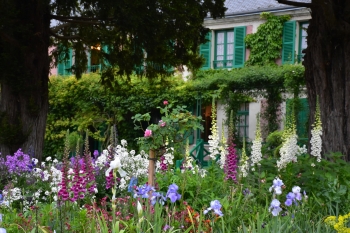
Monet’ house at Giverny, mid-May. Click to enlarge.
Some flower names sound really strange, like foxgloves. These tall and beautiful flowers (also called digitalis) photographed here at the top of the main alley in Claude Monet’s flower garden like the shade of the two old yews. Under the dark branches, they feel at home, as if they had just escaped from a wood. They thrive in the forests of Normandy, wherever the soil is acidic enough.
With their spiky shape they resemble fairy hats, what leads us to the origin of their common name. According to a friend of mine, foxgloves derive from folks gloves, these folks being the fairies, of course. I don’t know if it’s true, but I like this explanation…
by Ariane ~ May 8, 2018
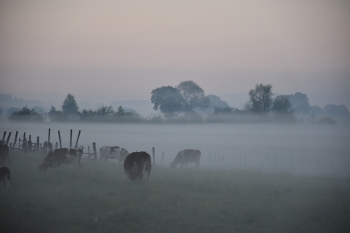
Just before sunrise, a light mist arises from the meadows of Giverny and Vernon. Cows that stay outside from April to November are already eating their breakfast. Different breeds can be found in the same herd. The ones pictured here are Rouges des Prés, which means Reds of the Meadows, formerly called Maine-Anjou after a region in the Loire valley.
Three weeks ago they were brought to the field by trucks, together with the calves. The young ones had never seen anything else than the stable. They looked excited, running around like children in the schoolyard. When you watch them, you cannot help but share their joy. They have now calmed down, though their motions are still more lively than those of their mothers.
I can see the cows through the window when I look up from the screen of the computer. They are very familiar neighbors, but one day they surprised me. Two teams were playing soccer in the football field nearby. The cows probably wondered what happened. They lined along the fence and watched. Or maybe they just wanted to know who was going to win.
by Ariane ~ April 23, 2018
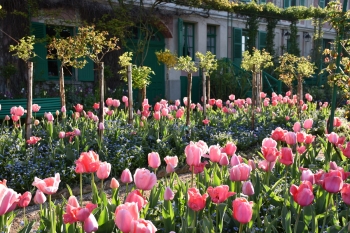
The name of Monet and his garden at Giverny evoke specific flowers: water lilies, wisterias, irises in large rows… It rarely brings up images of tulips. The big tulip show of April is a surprise to many visitors.
Tulips in Monet’s times were not yet what they are now, but Monet planted them and painted them, especially on the dining-room doors of his art dealer Paul Durand-Ruel. They are so colorful and charming that a painter can only fall under their spell.
10 000 bulbs are planted yearly in Monet’s gardens at Giverny. During the first weeks after the opening, they pop out of the ground, form their thick buds and open all of a sudden at the first ray of sunshine. It is like a canvas suddenly covered by paint, each of them being a brushstroke. It may be the time of year when the feeling of walking in a painting is at its strongest in the flower garden designed by Claude Monet.
by Ariane ~ April 7, 2018
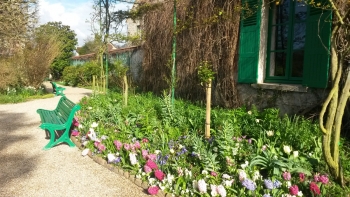
The blooming of hyacinths is the sign that Spring has arrived at last. In Monet’s garden they are planted by hundreds. They are beautiful for their colors ranging from white to pale yellow, pink, purple, blue and even almost black, but to tell the truth it is their scent that makes them irresistible.
If we humans would wear that much perfume, it would be a nuisance for people next to us. However, for flowers, rules are different. The more fragrance the better.
We love walking or sitting in an air that is full of their delicious smell. Spontaneously we close the eyes to concentrate better on this experience. Colors forgotten, it is a treat to be nostrils only, taking in the best of springtime.
by Ariane ~ March 15, 2018
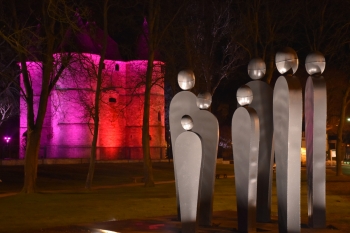
Near the bridge on the Seine in Vernon, the turret castle dates back to the 12th century. Next to it, the modernity of a sculpture in galvanized steel creates a strong contrast. This group called ‘People’ was granted to the town of Vernon by its designer, Olivier Gerval, in 1998.
by Ariane ~ March 6, 2018
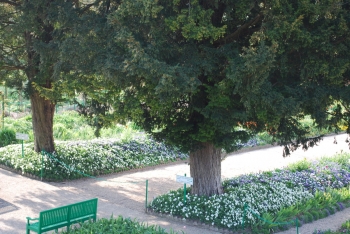
Seen from Monet’s bedroom, these two imposing trees are yews. They were not planted by Claude Monet: they are older. He found them when he arrived at Giverny. They appear on old photos, although we don’t know of any pic that is from the eighteen eighties. The garden became the focus of photographers after its transformation by Monet and most photos are from the twentieth century.
Yews are extraordinary trees. They can live up to 1500 years. In our region of Normandy they are planted near churches in cemeteries. They were certainly symbolic and magic as well. Chapels dedicated to the Virgin were installed in some very old specimens.
Monet’s two yews in comparison are young boys, only two hundred years old. But they’ve witness so many events, so many people paying a visit to Monet and later touring his garden that their memories would be amazing, if they were willing to share…
by Ariane ~ February 19, 2018
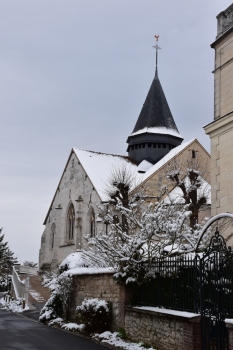
It was lovely last week to see the snow covered roof of Giverny’s church. It’s unusual here and never lasts long. This may be the reason why snow looks lovely for the inhabitants of Monet’s village, because on the other hand it makes life more complicated. As snow is rare, nothing is organized for it, especially transportation. Kids don’t go to school anymore, trucks are not allowed to drive and shops don’t get fresh goods. Fortunately after a couple of days snow vanishes and life is normal again.
by Ariane ~ February 7, 2018
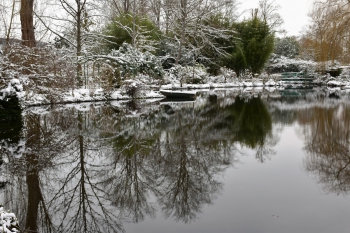
Some snow has fallen on Giverny! Claude Monet’s pond that will be graced with water lilies in summer is not frozen. It reflects the evergreen bamboos and the snow covered shrubs and trees around. The roots of the water lilies are dormant under the surface, waiting for warmer times to come. In the distance you can see the Japanese footbridge and its canopy of wisteria, all white for the moment. (Click for larger picture)
by Ariane ~ January 31, 2018
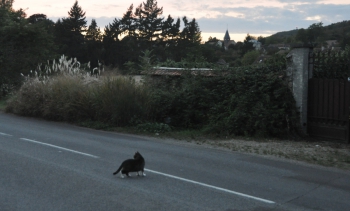
The little triangular roof you can spot in the distance is the bell tower of Giverny’s church. This cat is crossing the main road, chemin du Roy, without any fear from cars and buses. Sunset is a peaceful time in Claude Monet’s village, just like winter.
In French the expression for ‘there isn’t a soul’ is ‘il n’y a pas un chat’, there isn’t a single cat. You could say ‘il n’y a pas âme qui vive’, not a living soul, but it is elevated language.
Actually sunset and winter are the best time for cats to live their own life at Giverny, when the streets are theirs again. They all belong to somebody – no wild turned cats here, as it may be the case in cities, but cats roaming and exploring their territories.
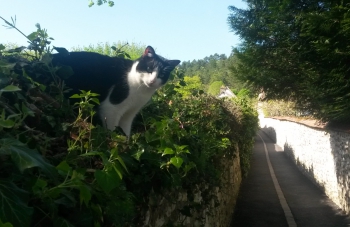
They are wonderful to look at. They are fabulously supple, bouncy, capturing with their eyes, nostrils and whiskers details we have no idea about. They stop unexpectedly in their walk, watching. They jump to the top of the wall, they walk along like a funambulist. They feel at home everywhere, including in Monet’s gardens.
by Ariane ~ January 1, 2018

Vernon’s motto is Vernon semper viret, Vernon ever green, and it is true that it rarely snows in the valley of the Seine. The last year a foot of snow fell on Giverny was in 2012…
This is why it is inspiring to see these snow-covered fir trees in front of the Eglise Notre-Dame and the tourist information office. Do you like the red ones too?
Whether it is mild, warm or ice-cold where you live, I wish you a happy New Year and all the best for you and your loved ones in 2018.
by Ariane ~ December 11, 2017

Are you curious about flower names? Would you enjoy a picture a day of Giverny’s flowers? This new perpetual calendar is great to get familiar with the flowers that grow in Claude Monet’s gardens. I’ve sorted out my best pictures and identified the flowers with the help of the Giverny gardeners. Botanical name, common name, even French name and photo date are specified for each flower.
On some pictures you will recognize the place in the background, just like the poppy picture on the cover. This perpetual calendar is for Giverny lovers and flower lovers alike.
The cost is 19 euros + shipment. If you can wait for 2 weeks, the shipment is 4 euros only. Just drop me a comment and I will be back in touch with the details.
Enjoy December!
by Ariane ~ November 6, 2017
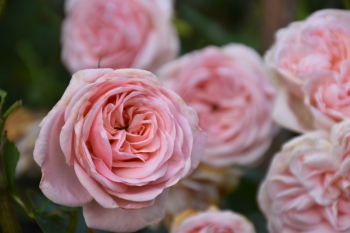
Giverny has been closed since the 1st of November 2017. Claude Monet’s house and gardens will reopen on the 23rd of March 2018.
The last day, I went photo hunting for the last flowers. That’s a special kind of safari, totally harmless but I found it exciting. These roses are my best prey. Yes, there are still a few roses in Fall at Giverny, as long as it doesn’t freeze. Sometimes they last up to Christmas.
by Ariane ~ October 6, 2017
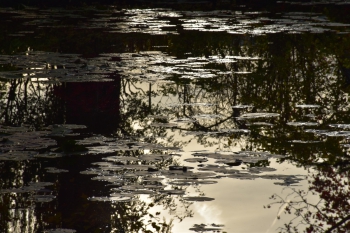
This is not black and white, it’s a color pic of Giverny.
In back light the colors disappear on Monet’s pond.
They are turned into shades of grey or sepia.
The picture resembles a vintage photo.
Reducing the colors makes the light look more vibrant.
by Ariane ~ September 23, 2017
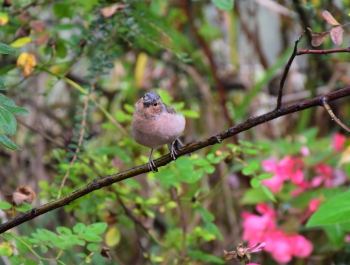
This fat boy is a finch. Finches are the most common birds at Giverny. They are easy to recognize with their pink belly and their grey hood. They sing, they hop around, they don’t seem to care about visitors. They live their own lives.

Like butterflies, birds bring their own magic into the garden of Monet.
Robins are also common and cute with their scarlet belly. When gardeners work, the robin that ‘owns’ the place is never very far away. And gardeners work at Giverny on a daily basis…

by Ariane ~ September 2, 2017
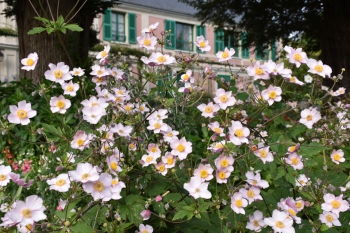
Late summer is a feast for the eyes in Monet’s gardens at Giverny.
Japanese anemones, among many other flowers, are at their best.
Claude Monet grew them along the main alley.
He loved their elegant white flowers popping out against a beautiful green foliage.
On the photos taken in his times, simple white Japanese anemones can be seen.
Nowadays they also exist in pink and can be double or even fluffy.
All of them are lovely perennials that last for decades.










